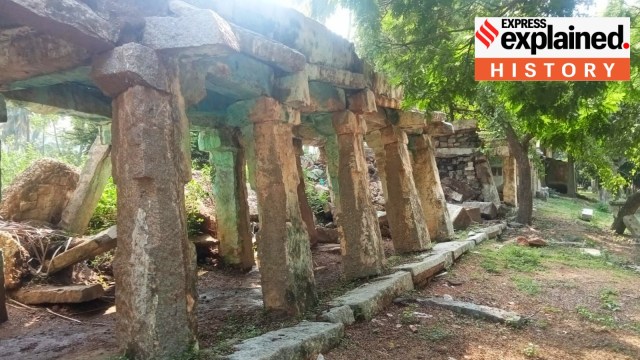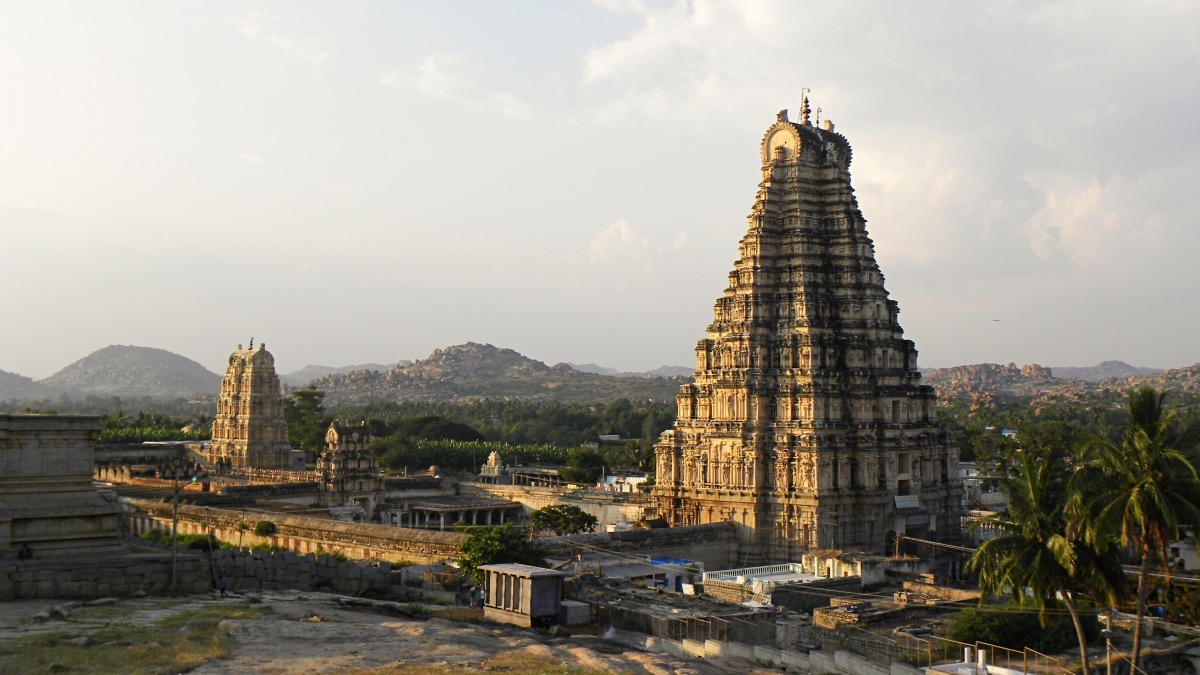A portion of the Virupaksha temple in Karnataka collapsed following torrential rains on Tuesday (May 21). Located at the historical site of Hampi, the temple’s pavilion or the saalu mantap was damaged, leading some conservationists to blame Archaeological Survey of India (ASI) officials for allegedly neglecting its protection and conservation.

A nationally protected monument and a UNESCO World Heritage Site, the temple is believed to have its origins in the 7th century. Here is what to know about its history, significance, and the restoration work that is currently underway.
What is the Virupaksha temple’s historical significance?
Despite legends about its origins going further back, the Virupaksha temple gained prominence and underwent extensive expansion in the 14th century during the Vijayanagara Empire (1336 to 1646).
Founded by Harihara I of the Sangama dynasty, the Vijayanagara empire expanded from a strategic position on the banks of the Tungabhadra river to become one of the most powerful kingdoms of its time.
 An earlier view of the Virupaksha Temple in Hampi, Karnataka. (Via Wikimedia Commons)
An earlier view of the Virupaksha Temple in Hampi, Karnataka. (Via Wikimedia Commons)
The temple flourished under the patronage of the Vijayanagara rulers, who were great builders and patrons of art. It became a vital centre for the religious and cultural activities of its time.
It is a prime example of Dravidian temple architecture, characterised by its grand gopurams (towering gateways), the shikhara towering over the sanctum sanctorum, its intricate carvings and pillared halls. Richly adorned with carvings and sculptures, the gopuram depicts various deities, mythological scenes and animals.
Story continues below this ad
The sanctum sanctorum houses the Shiva lingam, the main object of worship. Historians say all temples had pavilions where traders sold articles, such as those used in worship. Sometimes devotees visiting the temple also camped under the pavilions.
With several other temples and structures located there, Hampi was the empire’s capital city and stands today as evidence of what is known as the last ‘great Hindu empire’ of South India. UNESCO also recognised its uniqueness and categorised the Group of Monuments at Hampi as a World Heritage Site.
What caused the Virupaksha temple pavilion to collapse?
The pavilion was constructed using stone pillars. According to ASI officials, the pillars’ condition has deteriorated because of natural phenomena such as rain over a long period.
Nihil Das, Superintendent Archaeologist of the ASI’s Hampi Circle, said: “Only three metres of the 19-metre-long pavilion, consisting of four pillars, are damaged due to heavy rain. The entire pavilion was set for restoration and we were also aware that these pillars lacked strong foundations. However, as per our estimation, we thought the pillars would last at least for another four to five years. But it collapsed very early… These stone pillars were subject to very heavy rains in the past and the foundation of the pavilion also lost its strength gradually, leading to the collapse,” said Das.
Story continues below this ad
How is the ASI restoring the Virupaksha temple?
The ASI is responsible for 57 out of the 95 monuments in Hampi that are nationally protected, while the rest are under the state government’s control. Before beginning the restoration work, ASI digitally documented all the monuments under its control.
The restoration work began in 2019, with the first phase completed between 2019-20 and the second phase completed between 2022-22. The pavilion was also supposed to be restored later on. Now that a portion is damaged, the ASI is dismantling the entire pavilion and will undertake restoration work on a priority basis.
Soon after the incident, the Hampi Circle of ASI constituted a committee of senior archaeologists, conservationists and engineers who will review and document the monuments to check the damage and restoration requirements. Das said it was to protect the monuments and ensure the structures do not suffer further damage.
The works will be classified as major or minor repairs, based on which their restoration will be done. A final report on the monument’s assessment and funds for restoration will be submitted to the Director General of ASI.
Story continues below this ad
What are the challenges in restoring monuments?
ASI officials stated that issues related to funding, logistics and human resources are the key challenges they face while taking up restoration work. According to Das, Rs 8 crore was granted in the last financial year by the Central government for the restoration of monuments in the Kalyan Karnataka region, stretching from Vijayanagar to Bidar.
Further, the restoration of stone pillars requires the same type of stone used initially and is done through a traditional method, which is time-consuming. Das said restoring the dismantled pavilion will cost roughly Rs 50 lakhs and is expected to be completed in three to four months.
The UNESCO website also noted broader concerns about the heritage site’s preservation. “The Virupaksha temple is in constant worship, this has led to many additions and alterations to different parts of temple complex. Similarly, the haphazard growth of modern shops, restaurants in and around it and its bazaar that caters to religious and social tourists has impacted adversely on its setting as has the asphalting of the roads over the ancient pathway in front of the Virupaksha temple. The tensions between modern uses and protecting the fabric and setting of the ancient remains need to be managed with the utmost sensitivity.”



 An earlier view of the Virupaksha Temple in Hampi, Karnataka. (Via Wikimedia Commons)
An earlier view of the Virupaksha Temple in Hampi, Karnataka. (Via Wikimedia Commons)




































